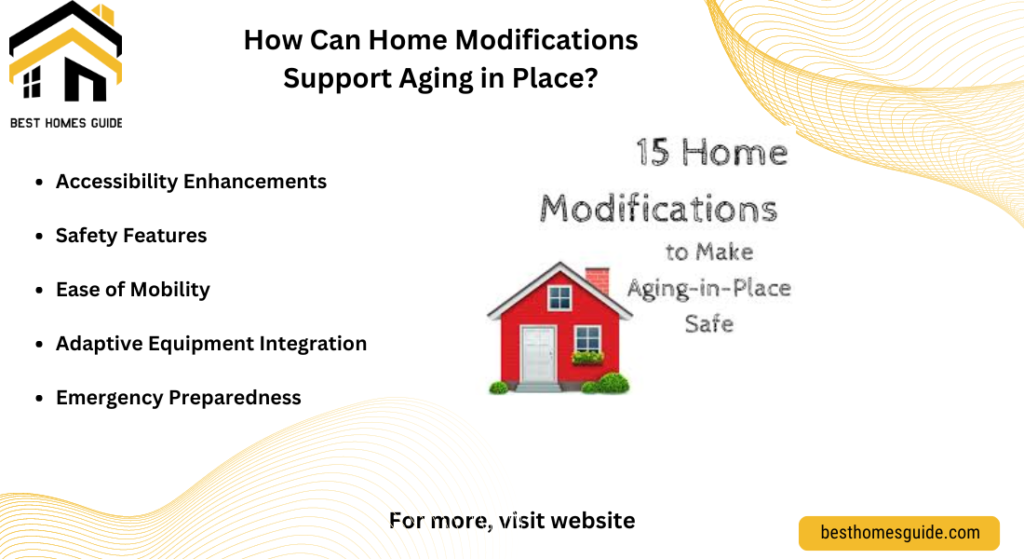Aging in place is a growing trend among seniors who wish to maintain their independence and stay in the comfort of their own homes, they age. This concept emphasizes living in a familiar environment, surrounded by the community and support systems one has built over a lifetime. With the right modifications and support, aging in place allows older adults to enjoy a high quality of life, fostering a sense of autonomy and security.
Advancements in technology, healthcare, and community resources have made it increasingly feasible for seniors to age in place safely and comfortably. From smart home devices that enhance security to healthcare services that deliver care directly to the home, aging in place offers numerous benefits and solutions tailored to meet the diverse needs of older adults. As society continues to evolve, understanding and facilitating aging in place will become increasingly important for ensuring that seniors can lead fulfilling lives in their own homes.
- Independent living, senior home modifications, home safety for seniors
- in-home care services, community resources for aging adults
- smart home technology for seniors
- healthcare for seniors at home
This introduction sets the stage for a comprehensive exploration of aging in place, highlighting its significance and the evolving strategies that make it a viable option for many seniors.
How Does Aging in Place Compare to Assisted Living?
Aging in place and assisted living are two distinct paths that seniors can take as they grow older, each offering unique benefits and challenges. Aging in place allows seniors to remain in their own homes and communities, maintaining a sense of familiarity and independence. This option is often more affordable than assisted living since it eliminates the need for costly facility fees. It offers a personalized approach to care, where seniors can receive support tailored to their specific needs from family members, friends, or professional caregivers.
Assisted living facilities provide a communal living environment where seniors can access 24-hour support and services such as meal preparation, medication management, and social activities.These facilities are designed to offer a comprehensive care solution for seniors who may require more constant assistance than what can be provided at home. The trade-off is often less independence and higher costs compared to aging in place.
The choice between aging in place and assisted living depends on several factors, including the seniors health, financial situation, and personal preferences. For those who value autonomy and have a robust support network, aging in place can be an empowering and fulfilling option. On the other hand, seniors who need more intensive care might find assisted living to be a more suitable choice.
Why Do Most Seniors Prefer Aging in Place?
Aging in place resonates with many seniors because it provides them with the comfort and stability of staying in a familiar environment. The home is more than just a physical space; it is imbued with memories and a sense of identity that can be comforting during the aging process
.Many seniors associate their homes with independence and self-reliance, making the prospect of aging in place particularly appealing.
Aging in place offers significant emotional and psychological benefits. Staying in one’s own home can lead to increased life satisfaction, self-esteem, and quality of life. It allows seniors to maintain their routines and connections with neighbors and community members, which can be vital for mental health and well-being. By aging in place, seniors can also have greater control over their daily activities, which is essential for their dignity and autonomy.
Seniors prefer aging in place is the ability to maintain personal freedom and customize their living environment. With the aid of modern technology and home modifications, seniors can adapt their homes to better suit their needs, enhancing safety and accessibility without sacrificing independence. This adaptability ensures that aging in place can be a viable option for many seniors who wish to stay in their homes for as long as possible.
How Can Home Modifications Support Aging in Place?
Home modifications are crucial in facilitating aging in place by making living spaces safer and more accessible for seniors. These modifications range from simple adjustments, like installing grab bars in bathrooms and improving lighting, to more extensive renovations, such as adding ramps and stairlifts. These changes help mitigate common hazards that could lead to falls or injuries, allowing seniors to navigate their homes confidently and independently.
Enhancing home safety through modifications is vital for preventing accidents. For example, replacing slippery floor surfaces with non-slip materials and removing tripping hazards like loose rugs can significantly reduce the risk of falls. Upgrading bathroom fixtures, such as adding shower chairs and handheld showerheads, can make daily tasks easier and more comfortable for seniors.
Technology also plays a significant role in supporting aging in place through home modifications. Smart home devices, such as automated lighting, voice-activated assistants, and security systems, can offer seniors greater control their environment and provide peace of mind for both seniors and their families. By integrating these technologies into their homes, seniors can enhance their quality of life while maintaining the independence they cherish.

What Financial Considerations Are Important for Aging in Place?
Financial planning is a crucial aspect of successfully aging in place. It involves assessing current financial resources and planning for future expenses to ensure long-term stability. A significant consideration is the cost of home modifications, which can range from minor adjustments, like installing grab bars, to more extensive renovations, such as adding ramps or stairlifts. It’s essential to budget for these expenses early, as they are often necessary to ensure a safe and accessible living environment.
A key financial aspect is managing ongoing living expenses. These include property taxes, insurance, utilities, and maintenance costs, which can be unpredictable. Seniors should evaluate their income sources, such as retirement savings, pensions, and Social Security benefits, to ensure they have a steady cash flow to cover these costs. Exploring options like home equity loans or reverse mortgages can provide extra financial resources if needed.
Healthcare expenses can be a significant burden for seniors aging in place. Long-term care insurance and Medicaid can help cover costs associated with in-home care or medical services. Creating a comprehensive financial plan that includes emergency funds and accounts for potential healthcare needs is vital to avoiding financial strain and ensuring peace of mind.
How to Plan for Health Care Needs While Aging in Place?
Planning for healthcare needs is an integral part of aging in place, as it ensures that seniors have access to necessary medical services without leaving their homes. One important step is conducting a health assessment to understand the level of care required, which may range from occasional visits by healthcare professionals to more regular in-home care. This assessment helps in creating a personalized care plan that addresses specific health conditions and needs.
Medication management is a critical component of healthcare planning for seniors. Many older adults may have multiple prescriptions, which can be challenging to manage independently. Utilizing medication management tools, such as pill organizers or automated dispensers, can help ensure adherence to medication schedules. In cases where more assistance is needed, hiring a professional caregiver or nurse to oversee medication management may be necessary.
Access to telehealth services can significantly enhance healthcare management for seniors aging in place. These services allow seniors to consult with healthcare providers remotely, reducing the need for frequent trips to medical facilities. Telehealth can be particularly beneficial for routine check-ups, monitoring chronic conditions, and accessing specialist care, providing convenience and flexibility for both seniors and caregivers.
What Community Resources Are Available for Aging in Place?
Community resources play a vital role in supporting seniors who choose to age in place, providing access to various services and programs designed to enhance quality of life. Local community centers and senior organizations often offer activities, social events, and support groups that help seniors stay engaged and connected with others.These programs can reduce feelings of isolation and improve mental health and well-being.
Transportation services are another critical community resource for seniors aging in place. Many communities offer specialized transportation options for seniors, enabling them to attend medical appointments, run errands, or participate in social activities. Access to reliable transportation helps maintain independence and mobility, which are crucial for aging in place.
community-based health services, such as visiting nurses and home health aides, provide essential support for seniors managing chronic conditions or recovering from illness or injury. These services ensure that seniors receive the medical attention they need while remaining in their homes. Collaborating with community organizations and leveraging available resources can greatly enhance the aging-in-place experience, allowing seniors to live independently and comfortably for as long as possible.

How Can Family and Caregivers Support Aging in Place?
Family and caregivers are essential in helping seniors successfully age in place by providing practical, emotional, and social support. Family members can assist with daily tasks such as meal preparation, cleaning, and running errands, ensuring that the senior’s home remains a safe and comfortable environment. Family involvement can enhance emotional well-being by reducing feelings of loneliness and providing a sense of security.
Caregiving can be a demanding role, so it is important for families to share responsibilities to prevent burnout and ensure consistent care. Utilizing respite care services can offer family caregivers a much-needed break while ensuring that the senior continues to receive quality care. Friends and neighbors can also contribute by providing companionship and assisting with transportation to appointments or social engagements.
Collaboration between family, friends, and professional caregivers is creating a comprehensive support system that meets the senior’s needs. Professional in-home care services can provide specialized assistance with medical tasks, medication management, and personal care, complementing the support offered by family and friends. This collaborative approach ensures that seniors receive holistic care tailored to their preferences and health requirements.
What Are the Challenges and Solutions for Aging in Place?
While aging in place offers many benefits, it also presents several challenges that need to be addressed to ensure safety and well-being. The primary challenge is maintaining a safe home environment that accommodates the physical limitations that may come with aging. Home modifications such as installing grab bars, improving lighting, and removing tripping hazards are crucial for preventing falls and other accidents.
Healthcare accessibility is another challenge, as seniors may require frequent medical visits or specialized treatments. Telehealth services and in-home healthcare providers can offer convenient solutions by bringing medical care directly to the senior’s home. Medication management tools and regular check-ins by healthcare professionals can help seniors adhere to their treatment plans and manage chronic conditions effectively.
Isolation and loneliness can also be significant issues for seniors aging in place. Building a strong social support network through community engagement, participation in social activities, and maintaining connections with family and friends can mitigate these feelings. Community centres and local organizations often offer programs and activities designed to keep seniors active and socially connected.
How to Evaluate If Aging in Place is the Right Choice?
Evaluating whether aging in place is the right choice requires a thorough assessment of various factors, including health, safety, and support systems. One crucial aspect to consider is the senior’s physical and cognitive health. If the individual can perform daily activities with minimal assistance and manage any chronic conditions effectively, aging in place can be a suitable option. If there are significant health concerns that require constant supervision or specialized care, alternative living arrangements may be necessary.
An important consideration is the safety of the home environment. Evaluating the current state of the home for potential hazards, such as stairs, slippery surfaces, and inadequate lighting, is essential.Ensuring the home can be modified to accommodate the senior’s needs is crucial for creating a safe living space. The availability of community resources and support networks can significantly influence the decision, as they provide essential services that can help maintain independence.
Financial readiness is also a key factor. Seniors and their families should assess whether they have the financial resources to cover the costs associated with home modifications, in-home care, and potential medical expenses. Consulting with a financial advisor can help create a sustainable plan that ensures long-term financial stability while aging in place.

Creating a Comprehensive Care Plan for Aging in Place
A comprehensive care plan is essential for successfully aging in place, as it outlines the support and services needed to maintain independence and well-being. The first step in creating a care plan is conducting a thorough assessment of the senior’s health needs, including physical, cognitive, and emotional requirements. This assessment helps identify the types of support needed, such as medical care, personal assistance, and social engagement.
The care plan should also include details about the roles and responsibilities of family members, caregivers, and healthcare professionals involved in providing care. Establishing clear communication and coordination among all parties ensures that the senior receives consistent and comprehensive support. Regularly reviewing and updating the care plan is important to adapt to changing needs and circumstances.
Integrating technology into the care plan can enhance safety and convenience. Tools such as medication management apps, remote health monitoring devices, and emergency alert systems can provide peace of mind and support independent living. By leveraging these technologies, seniors can maintain their autonomy while accessing necessary care and services.
Making Necessary Home Modifications for Aging in Place
Home modifications are a critical component of aging in place, as they enhance safety and accessibility within the living environment. Common modifications include installing grab bars and non-slip mats in bathrooms to prevent falls, improving lighting throughout the home, and widening doorways to accommodate mobility aids. These changes help create a safe and comfortable space that meets the senior’s needs.
For seniors with mobility challenges, adding ramps and stairlifts can facilitate movement within the home . Adjustments to the kitchen and bathroom, such as lowering countertops and installing walk-in tubs, can also improve accessibility. These modifications not only enhance safety but also promote independence by enabling seniors to perform daily tasks more easily.
Consulting with a Certified Aging-in-Place Specialist (CAPS) can provide valuable guidance on the most effective modifications for a particular home. These professionals are trained to assess the specific needs of seniors and recommend tailored solutions that support aging in place. And Investing in appropriate home modifications, seniors can enjoy a higher quality of life and remain in their homes longer.
How Can Technology Facilitate Aging in Place?
Technology plays a significant role in facilitating aging in place by enhancing safety, convenience, and connectivity for seniors. Smart home devices, such as automated lighting, thermostats, and security systems, allow seniors to control their environment easily and ensure their safety. These technologies can also provide peace of mind to family members by enabling remote monitoring and alert systems that notify them of any unusual activity.
Health-related technologies, such as telehealth services, remote health monitoring devices, and medication management apps, offer seniors access to healthcare without leaving their homes. These tools help seniors manage chronic conditions, adhere to medication schedules, and maintain regular communication with healthcare providers, ensuring that they receive timely medical attention when needed.
Social connectivity is another area where technology can significantly impact aging in place. Video calling platforms and social media allow seniors to stay connected with family and friends, reducing feelings of isolation and loneliness. Online communities and virtual activities provide opportunities for engagement and learning, keeping seniors active and mentally stimulated.
Aging in place is an increasingly popular choice for seniors who wish to maintain their independence and stay in their own homes as they grow older. Successfully aging in place requires careful planning and consideration of various factors, including health, safety, and financial readiness. By creating a comprehensive care plan, making necessary home modifications, and leveraging technology, seniors can enjoy a high quality of life and continue to thrive in their familiar surroundings.
The role of family, caregivers, and community resources is crucial in providing the support needed for aging in place. By working together, and Reverse mortgage guide and sharing responsibilities, they can ensure that seniors receive the care and assistance required to meet their evolving needs. Regularly assessing the suitability of aging in place and adapting plans as circumstances change is vital to ensuring the senior’s well-being and safety.
